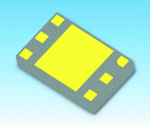Laird Technologies’ RadioAnt internal FM antenna
According to developers at Laird Technologies, Laird’s RadioAnt internal FM antenna resulted in many industry firsts: the first to match the performance of a headset wire, the first commercially successful active handset antenna, and the first to use high-performance millimeter-wave semiconductor technology in a low-frequency consumer product. But, whatever technological advancements the RadioAnt has achieved, the key to its success — and selection for an Electronic Products 2007 Product of the Year award — is simply its ability to relieve the long-used headset cord from FM radio reception duties.

Beginnings
Although work on internal FM antennas has been going on since the mid-1990s, the company took its first real steps toward the active design concept in July 2005, when Laird project members Dr. Peter Lindberg, Dr. Andrei Kaikkonen, and Lukasz Grynczel collaborated with the microwave group of Sweden’s Uppsala University, led by Professor Anders Rydberg. The team was able to tap into their extensive experience to ultimately prove that purely passive solutions are inherently flawed.
The FM application was selected as a test case because it was receive only, wideband (> 30%), and there was no available passive solution at the time that could provide adequate performance.
Design hurdles
The project presented many challenges. To start with, it turned out that the developers didn’t really know how to measure antenna performance other than by simply connecting it to a radio and listening to the audio quality.
The many gain measurements in the outdoor range resulted only in inconsistencies with the user experience. An antenna with poor gain had decent reception in field tests, while another antenna with even better gain had almost no reception at all.
It was not until after researchers developed a fiber-optic-based cable replacement system that they realized having any cables connected to such a small antenna introduced a measurement error of over 20 dB. No amount of ferrites or other cable-decoupling devices helped significantly.
Circuit and radiator design posed a great challenge as well. For the low-noise amplifier, there are dozens of semiconductor processes and transistor technologies that can potentially be utilized—all of which look good on paper but of which only a select few are usable for internal FM applications. As there was no prior experience documented, the investigations were all done from scratch.
With passive antennas, resonant radiators have been shown to obey fundamental limits in terms of bandwidth (the so-called ‘Chu-limit’), which, it turns out, is not applicable to active antennas—a little known fact in the antenna community. Additionally, researchers were faced with many other little known properties of less than 1-GHz wireless applications—the impact of high surrounding noise temperatures; EMI sources inside the handset; the positive body effect (completely opposite to the massive performance degradation appearing in the talk position of cellular antennas); consistency between field tests and more rigorous gain; and noise measurements made on the stand-alone antenna.
Developers also made many systems measurements of the demodulated received FM signal together with suppliers of FM Rx / Tx modules to show the system performance of the antenna relative to a headset wire of full-sized dipole. Again, the researchers were forced to devise completely new measurement setups (for instance, fiber-optic cable replacements for audio frequencies) and figures of merit since such measurements are not very common in other wireless applications such as cellular.
Significant application areas
As far as the company is concerned, the timing of the project was almost perfect because FM radio modules had become a standard feature in a great majority of available cell phones. Unburdening the user from having to use the headset wire for reception — or even at all if they have a Bluetooth earpiece — will prove a very valuable advancement in listening to radio with a cell phone.
The company also notes that FM Tx was just legalized worldwide, and in conjunction with the enormous popularity of using mobile phones as MP3 players, a demand for short-range FM transmission between the mobile phone and the car radio was created almost overnight. Fortunately for Laird, it turned out that the radiator in RadioAnt could be reused for transmission without compromising reception quality.
Currently, Laird is focusing on modularizing the design, and later this year the electronic part will be offered as a single molded 3 x 3-mm2 component with pins that connect to the FM Tx module, the FM Rx module, the Bluetooth module, the headset, and the half-loop radiator.
Special materials and tools
A nonlinear circuit simulator was used for radiator analysis / synthesis. As measurements on the stand-alone radiator are nearly impossible with sufficient accuracy, excellent simulation models are necessary for predicting the system performance of the active antenna and to guide the optimization work.
For instance, stability analysis requires exact models of the radiator, the amplifier schematic and detailed circuit layout to be meaningful, and as the amplifier has positive gain well within the 10s of GHz range, this implies that minor details that are insignificant at the application frequencies around 100 MHz can cause oscillations at approximately 20 GHz.
To further complicate things, none of the conventional techniques for ensuring unconditional stability are applicable as they all imply some sort of resistive loading—an option not available when the radiation resistance is so low that any additional ohms of resistance translates into several decibels of lost sensitivity.
Apart from commercial software for EM and circuit analysis, the researchers developed their own software in MATLAB for rapidly post-processing the measurement data from gain and noise measurements to calculate the figures of merit.
Advertisement
Learn more about Laird Technologies





